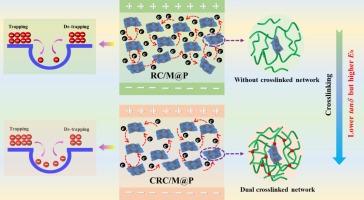Glutaraldehyde-assisted crosslinking for the preparation of low dielectric loss and high energy density cellulose composites filled with poly(dopamine) modified MXene
IF 5.8
2区 化学
Q1 POLYMER SCIENCE
引用次数: 0
Abstract
In today’s electric power systems, biodegradable and environmentally benign dielectric materials with outstanding dielectric capabilities are essential. Here, a hybrid filler MXene@PDA (M@P) was acquired by coating MXene with polydopamine (PDA), and then it was added into cellulose matrix to manufacture regenerated cellulose/M@P (RC/M@P) composite films. Finally, a crosslinking strategy with glutaraldehyde (GA) assistance was developed to further modify the RC/M@P composite films. The crosslinked composite films (CRC/M@P) had a denser structure with fewer defects, considerably decreased dielectric loss, and significantly strengthened breakdown strength. The highest energy storage density of 3.37 J/cm3 was obtained for CRC/M@P-1 composite film with only 1 wt% M@P at 361.07 MV/m, achieving significant enhancement compared with the original CRC film. Moreover, crosslinking also contributed to the CRC/M@P for achieving better mechanical properties. The excellent comprehensive performances endow CRC/M@P composite films with promising application for the next-generation dielectric capacitors.

戊二醛辅助交联用于制备填充聚(多巴胺)改性 MXene 的低介电损耗、高能量密度纤维素复合材料
在当今的电力系统中,可生物降解、对环境无害且具有出色介电能力的介电材料至关重要。本文通过在 MXene 上涂覆聚多巴胺(PDA),获得了混合填料 MXene@PDA(M@P),然后将其添加到纤维素基质中,制造出再生纤维素/M@P(RC/M@P)复合薄膜。最后,在戊二醛(GA)的辅助下开发了一种交联策略,以进一步改性 RC/M@P 复合膜。交联后的复合薄膜(CRC/M@P)结构更致密,缺陷更少,介电损耗大大降低,击穿强度显著增强。仅含有 1 wt% M@P 的 CRC/M@P-1 复合薄膜在 361.07 MV/m 的条件下获得了 3.37 J/cm3 的最高储能密度,与原始 CRC 薄膜相比有显著提高。此外,交联也有助于 CRC/M@P 获得更好的机械性能。优异的综合性能赋予了 CRC/M@P 复合薄膜在下一代电介质电容器中的应用前景。
本文章由计算机程序翻译,如有差异,请以英文原文为准。
求助全文
约1分钟内获得全文
求助全文
来源期刊

European Polymer Journal
化学-高分子科学
CiteScore
9.90
自引率
10.00%
发文量
691
审稿时长
23 days
期刊介绍:
European Polymer Journal is dedicated to publishing work on fundamental and applied polymer chemistry and macromolecular materials. The journal covers all aspects of polymer synthesis, including polymerization mechanisms and chemical functional transformations, with a focus on novel polymers and the relationships between molecular structure and polymer properties. In addition, we welcome submissions on bio-based or renewable polymers, stimuli-responsive systems and polymer bio-hybrids. European Polymer Journal also publishes research on the biomedical application of polymers, including drug delivery and regenerative medicine. The main scope is covered but not limited to the following core research areas:
Polymer synthesis and functionalization
• Novel synthetic routes for polymerization, functional modification, controlled/living polymerization and precision polymers.
Stimuli-responsive polymers
• Including shape memory and self-healing polymers.
Supramolecular polymers and self-assembly
• Molecular recognition and higher order polymer structures.
Renewable and sustainable polymers
• Bio-based, biodegradable and anti-microbial polymers and polymeric bio-nanocomposites.
Polymers at interfaces and surfaces
• Chemistry and engineering of surfaces with biological relevance, including patterning, antifouling polymers and polymers for membrane applications.
Biomedical applications and nanomedicine
• Polymers for regenerative medicine, drug delivery molecular release and gene therapy
The scope of European Polymer Journal no longer includes Polymer Physics.
 求助内容:
求助内容: 应助结果提醒方式:
应助结果提醒方式:


